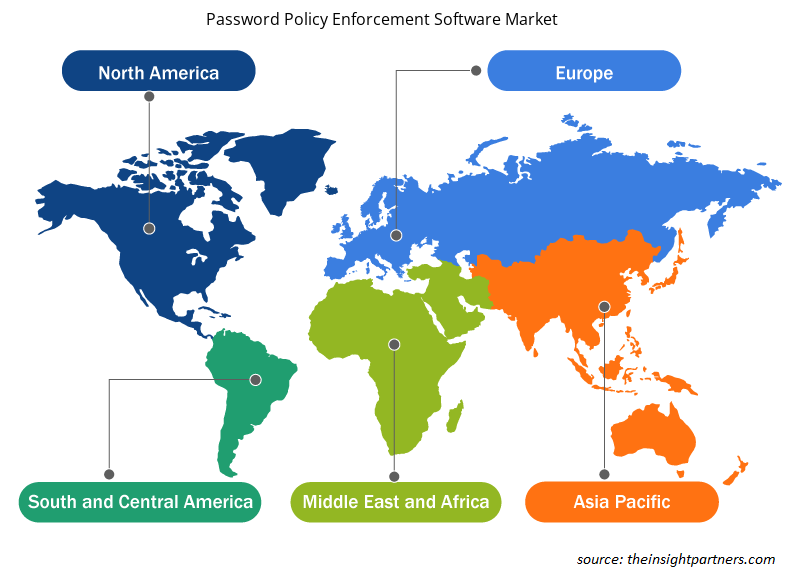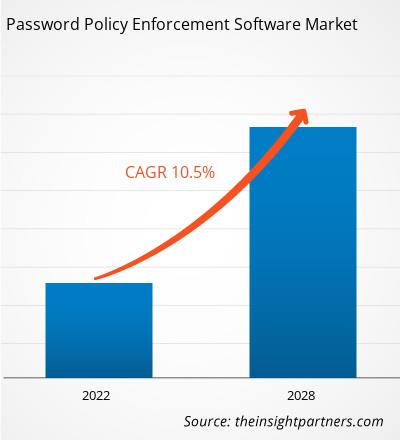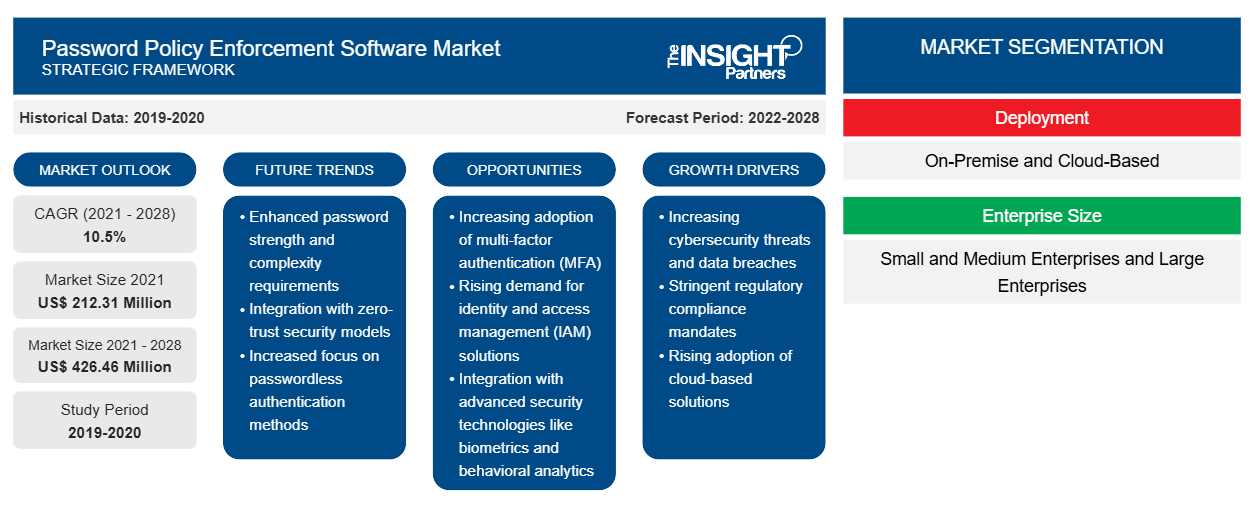Il mercato del software per l'applicazione delle policy sulle password è stato valutato a 212,31 milioni di dollari nel 2021 e si prevede che raggiungerà i 426,46 milioni di dollari entro il 2028. Si prevede che crescerà a un CAGR del 10,5% dal 2021 al 2028.
Le soluzioni software per l'applicazione delle policy sulle password assicurano che vengano utilizzate password complesse su tutte le piattaforme di un'azienda. Le organizzazioni installano software per l'applicazione delle policy sulle password per consentire agli utenti correlati di creare password che soddisfino le restrizioni delle policy sulle password aziendali in termini di complessità delle password, simboli, numeri, lettere maiuscole e minuscole, caratteri minimi e massimi. Le restrizioni assicurano inoltre che le password non contengano parole, frasi o password comunemente utilizzate, parole inserite nella blacklist specificata dall'azienda o password provenienti da dizionari di hacking noti.
Diversi fornitori digitali sono entrati nel mercato del software di applicazione delle policy sulle password con offerte semplificate per vari settori verticali industriali. Ad esempio, Netwrix Corporation fornisce un software di applicazione delle policy sulle password semplificato che soddisfa anche le esigenze più complicate in materia di policy sulle password consentendo a utenti, gruppi di dominio e unità organizzative di specificare fino a 256 regole per password locali e di dominio.
Il Nord America è uno dei mercati più importanti per il mercato del software di applicazione delle policy sulle password. Inoltre, si prevede che i continui miglioramenti delle tecnologie nei domini di analisi, cloud e tendenze BYOD forniranno al mercato regionale una spinta importante. Inoltre, un aumento della frequenza degli attacchi informatici ha suscitato preoccupazioni sulla sicurezza delle password, contribuendo alla crescita del mercato del software di applicazione delle policy sulle password.
Personalizza questo report in base alle tue esigenze
Riceverai la personalizzazione gratuita di qualsiasi report, comprese parti di questo report, o analisi a livello nazionale, pacchetto dati Excel, oltre a usufruire di grandi offerte e sconti per start-up e università
- Scopri le principali tendenze di mercato in questo rapporto.Questo campione GRATUITO includerà analisi di dati che spaziano dalle tendenze di mercato alle stime e alle previsioni.
Impatto della pandemia di COVID-19 sul mercato dei software per l'applicazione delle policy sulle password
L'enorme diffusione del SARS-CoV-2 ha spinto i governi di diversi paesi a imporre severe restrizioni alla circolazione di veicoli e persone. I conseguenti divieti di viaggio, blocchi di massa e chiusure aziendali emanati dai governi hanno influenzato le economie e le industrie di vari paesi, soprattutto nel 2020. L'imposizione del blocco ha anche ridotto la produzione di materie prime, beni e servizi. Al contrario, la pandemia di COVID-19 ha contribuito alla crescita del mercato dei software di applicazione delle policy sulle password nel 2020, poiché milioni di dipendenti sono stati invitati dalle loro aziende a lavorare da remoto. Seguire tali misure di protezione standard ha portato a una crescita nell'utilizzo di reti di terze parti, piattaforme digitali e dispositivi di elaborazione personali. Tali soluzioni di connettività di rete aumentano i rischi di violazioni dei dati e altri malware. A causa dell'aumento del rischio di reati informatici, le aziende cercano software di applicazione delle policy sulle password per rilevare e gestire qualsiasi comportamento anomalo nelle reti.
Market Insights – Mercato del software per l'applicazione delle policy sulle password
Progressi nel mercato dei software per l'applicazione delle policy sulle password
Sebbene vi sia una tendenza crescente verso metodi di autenticazione alternativi, le password stanno trovando una soluzione per "coesistere" e le password sono necessarie per il prossimo futuro. Prima che soluzioni sofisticate possano essere facilmente implementate, le password esistenti devono essere integrate con standard più recenti, come la biometria e l'autenticazione multifattoriale . Il fatto che le password non siano abbastanza forti da essere indipendenti non ne indebolisce l'importanza in termini di sicurezza. Quindi, anche se le password stanno per scomparire, le aziende dovrebbero attenersi alle proprie policy e garantire che il personale adotti un'igiene delle password. Le password vengono utilizzate per accedere alla tecnologia. Grazie a tecnologie come il Touch ID di Apple, il movimento senza password ha raggiunto un punto di svolta tecnologico: la tecnologia sta progredendo e i clienti sono stati preparati per l'autenticazione biometrica . I vantaggi delle configurazioni senza password vanno oltre i fattori di forma fisici. Gli utenti possono identificarsi tramite il viso, il tocco o la voce, ma i sistemi possono ora includere identificatori spaziali. L'analisi comportamentale è più difficile da compromettere e meno scomoda per l'utente.
Inoltre, gli utenti risponderanno sempre negativamente alla mancanza di familiarità o ai costi extra percepiti quando viene implementato un nuovo sistema di sicurezza. Tuttavia, l'autenticazione a due fattori e multifattoriale sta diventando sempre più popolare e sta dando i suoi frutti per chi la usa. Pertanto, si prevede che i progressi nel software di applicazione delle policy sulle password guideranno la crescita del mercato del software di applicazione delle policy sulle password nel prossimo futuro.
Informazioni basate sulla distribuzione
In base al tipo di distribuzione, il mercato del software per l'applicazione delle policy sulle password può essere suddiviso in on-premise e basato su cloud. Ci sono numerose considerazioni da considerare nel mondo IT aziendale odierno prima di decidere se un'infrastruttura cloud sia la soluzione perfetta. D'altro canto, molte aziende non sono in grado di effettuare la transizione al cloud, affidandosi invece ai loro collaudati sistemi e software legacy e on-premise per condurre gli affari.
Informazioni basate sulle dimensioni aziendali
In base alle dimensioni aziendali, il mercato del software per l'applicazione delle policy sulle password è suddiviso in piccole e medie imprese e grandi imprese. Le piccole e medie imprese (PMI) sono aziende con ricavi, asset o personale inferiori a una determinata soglia. Le piccole e medie imprese (PMI) sono definite in modo diverso in ogni paese. Le PMI svolgono un ruolo fondamentale nell'economia, nonostante le loro piccole dimensioni. Sono molto più numerose delle grandi aziende, impiegano un'enorme forza lavoro e sono imprenditoriali, contribuendo a dare forma all'innovazione.
Approfondimenti regionali sul mercato del software per l'applicazione delle policy sulle password
Le tendenze regionali e i fattori che influenzano il mercato del software per l'applicazione delle policy sulle password durante il periodo di previsione sono stati ampiamente spiegati dagli analisti di Insight Partners. Questa sezione discute anche i segmenti del mercato del software per l'applicazione delle policy sulle password e la geografia in Nord America, Europa, Asia Pacifico, Medio Oriente e Africa e Sud e Centro America.

- Ottieni i dati specifici regionali per il mercato del software di applicazione delle policy sulle password
Ambito del rapporto di mercato sul software per l'applicazione delle policy sulle password
| Attributo del report | Dettagli |
|---|---|
| Dimensioni del mercato nel 2021 | 212,31 milioni di dollari USA |
| Dimensioni del mercato entro il 2028 | 426,46 milioni di dollari USA |
| CAGR globale (2021 - 2028) | 10,5% |
| Dati storici | 2019-2020 |
| Periodo di previsione | 2022-2028 |
| Segmenti coperti | Per distribuzione
|
| Regioni e Paesi coperti | America del Nord
|
| Leader di mercato e profili aziendali chiave |
|
Densità dei player del mercato del software per l'applicazione delle policy sulle password: comprendere il suo impatto sulle dinamiche aziendali
Il mercato del software per l'applicazione delle policy sulle password sta crescendo rapidamente, spinto dalla crescente domanda degli utenti finali dovuta a fattori quali l'evoluzione delle preferenze dei consumatori, i progressi tecnologici e una maggiore consapevolezza dei vantaggi del prodotto. Con l'aumento della domanda, le aziende stanno ampliando le loro offerte, innovando per soddisfare le esigenze dei consumatori e capitalizzando sulle tendenze emergenti, il che alimenta ulteriormente la crescita del mercato.
La densità degli operatori di mercato si riferisce alla distribuzione di aziende o società che operano in un particolare mercato o settore. Indica quanti concorrenti (operatori di mercato) sono presenti in un dato spazio di mercato in relazione alle sue dimensioni o al valore di mercato totale.
Le principali aziende che operano nel mercato del software per l'applicazione delle policy sulle password sono:
- Gestisci motore
- Avieri
- Sistemi ID Hitachi Inc.
- Società per azioni Netwrix
- Società di sicurezza nFront Inc.
Disclaimer : le aziende elencate sopra non sono classificate secondo un ordine particolare.

- Ottieni la panoramica dei principali attori del mercato del software per l'applicazione delle policy sulle password
Gli operatori che operano nel mercato dei software per l'applicazione delle policy sulle password si concentrano principalmente sullo sviluppo di prodotti avanzati ed efficienti.
- Nel 2021, Netwrix ha acquisito PolicyPak per ampliare la propria offerta con la sicurezza degli endpoint. Si prevede che questa acquisizione rafforzerà il portafoglio prodotti di Netwrix ed estenderà la sua sicurezza e il controllo sugli account privilegiati ai desktop nei prossimi anni. PolicyPak e Netwrix insieme offrono soluzioni alle organizzazioni per la sicurezza contro attacchi informatici e hacker.
- A settembre 2020, ManageEngine ha annunciato che ADSelfService Plus supporta ora l'autenticazione a più fattori per proteggere le organizzazioni da qualsiasi accesso non autorizzato ai propri dati.
Mercato globale del software per l'applicazione delle policy sulle password: profili delle aziende
- Avieri
- Sistemi di identificazione Hitachi, Inc.
- Società per azioni Netwrix
- nFront Security, Inc.
- safepass.io
- Software di Specops
- Tools4ever (Gestore della complessità delle password (PCM))
- Zoho Corp (ManageEngine)
- JumpCloud Inc.
- Enzoico.
- Analisi storica (2 anni), anno base, previsione (7 anni) con CAGR
- Analisi PEST e SWOT
- Valore/volume delle dimensioni del mercato - Globale, Regionale, Nazionale
- Industria e panorama competitivo
- Set di dati Excel
Report recenti
Rapporti correlati
Testimonianze
Motivo dell'acquisto
- Processo decisionale informato
- Comprensione delle dinamiche di mercato
- Analisi competitiva
- Analisi dei clienti
- Previsioni di mercato
- Mitigazione del rischio
- Pianificazione strategica
- Giustificazione degli investimenti
- Identificazione dei mercati emergenti
- Miglioramento delle strategie di marketing
- Aumento dell'efficienza operativa
- Allineamento alle tendenze normative





















 Ottieni un campione gratuito per - Mercato del software per l'applicazione delle policy sulle password
Ottieni un campione gratuito per - Mercato del software per l'applicazione delle policy sulle password